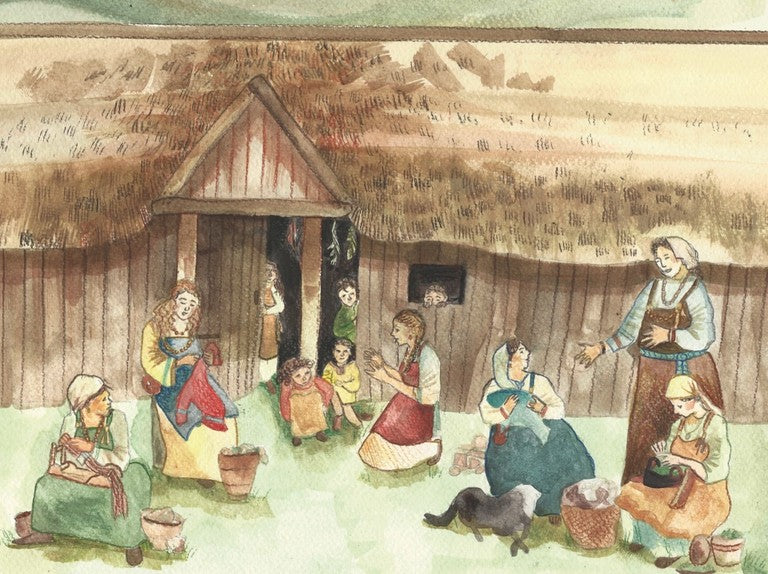Vikings had the necessity to learn Old Norse as both a way to communicate early on and establish what they were talking about, like referencing an object with the first three syllables and more often then not it had a future participation to other languages some of which are also included.
The explosion of trade and interaction brought about by the Viking Age created an increased need for writing and literacy, thus archaeologists have cataloged thousands of inscriptions in Younger Futhark while we only have hundreds in Elder Futhark. While seers and völva priestesses still used the runes to perceive the paths of the cosmos, we have found many runic inscriptions that were related to law or trade, or simply a man or woman carving their name on a personal item. Of course, the Vikings also left runic graffiti from Orkney to Constantinople and beyond as they pushed the boundaries of their world ever-further.
Reading and Writing Runes
The following tables offer a quick and basic introduction to the runes used by the Vikings and their ancestors. These charts should serve for those looking to transliterate their names or other epitaphs or to find known associations with particular meanings. Many books and other resources are available for deeper inquiry, but there is much about runes that is not known. Indeed, they are more mysterious now than they ever have been, but in words ascribed to Odin, when one understands the meanings of the runes they may find.


While Younger Futhark was the primarily choice during the Viking era (800 - 1050 AD), it is very likely that the Vikings could still use and interpret the Elder version (just as we can still interpret it today a thousand years later). Most of today's Viking rune jewelry uses the Elder version simply because letters translate easier to the English alphabet.
The similarities between many of the original Elder runes and today's English letters is undeniable. Sample translations include the following two words: LIFE and ODIN.
ANCIENT MAGIC AND RUNIC LORE!
It is no secret that the secret of runes is one of great power. After all, it was Odin himself who brought the runes to man, through is great act of sacrificing himself to himself “on the tree of which no man knows from where its roots run” (a reference to Yggdrasil, the tree of life).
It was Odin who, through the act of human sacrifice, sacrificing himself to himself, proved himself worthy of gaining both the knowledge and the power of the runes. After this, he was able to use runes to grant power, bless or curse, and even raise the dead (referenced in stanza 157 of Hávamál). As far as mysticism and lore are concerned, runes bring with them the power of the gods themselves.
Much like any power though, the power given to man through the runes was not something to be taken lightly, nor was it to be given to just anyone. Knowledge of the intimate nature of each individual rune was restricted to masters, nobles, kings, and magicians. They were the ones who understood the hidden meanings, the pairings of symbols, and the power of words! Rune Masters could inscribe a simple bracelet with runes, or even abbreviate incantations and carve them onto a tiny medallion and imbue it with powers and charms.
In the archaeological record we find dozens of examples of charmed items, with simple and extravagant engravings in Elder Futhark. Through these artifacts, we have learned that groupings of 3 runes at a time seemed particularly meaningful, as did simple groupings of rhyming symbols. And, though we cannot be 100% certain of their intended meaning, we have also found several common abbreviations for longer runic inscriptions on certain trinkets. Some of the most common include charm words, such as auja, laþu, laukaʀ, and alu.

WHAT DOES “RUNE” MEAN?
If you haven’t figured it out yet, words have meanings. And, many believe that words themselves have power; the power over what has been named by those words. This is the principle idea behind such practices as divination, spell casting, chanting, mantras, etc.
Runes each have a meaning, but where we should start is in the meaning of the word “rune” itself. “Rune,” or run-, runi, runa, as the root-word appears in several ancient dialects, has a unique sense about it. Each one of the terms used over the centuries has hinged on the idea of both speaking and of mystery. Runa, from the Gothic, translates more closely to “secret whisper” than anything else, while rhin in Old English translates to “secret writing.” In the Baltics, run- means “speech” and in Lithuanian, runoti means both to speak and to cut with a knife (possibly an early way to address the carving of words into stone or wood).

WHAT ARE RUNES?
To answer this question, runes are a writing system. Well, in truth, runes are the characters for a system of writing, but I digress. There are many runes that have been discovered. Many from the Scandinavian sailors we call Vikings and even a few unique ones discovered in the sacred sites of the Knights Templar (for real). Contrary to popular belief, there are actually many variations of Runic systems which have evolved over time, since the 2nd century all the way to roughly the 1,800’s. But as for typical modern day divination, there are only 24 which are commonly used.

The Vikings went through much of this at a young age but this was preparation and a necessity for bigger things to take hold like board games before going to war.
Works Cited
1. Viking runes guide: Runic alphabet meanings: Norse / Nordic letters. Sons of Vikings. (2017, February 28). Retrieved December 8, 2021, from https://sonsofvikings.com/blogs/history/viking-runes-guide-runic-alphabet-meanings-nordic-celtic-letters.








Leave a comment
This site is protected by hCaptcha and the hCaptcha Privacy Policy and Terms of Service apply.